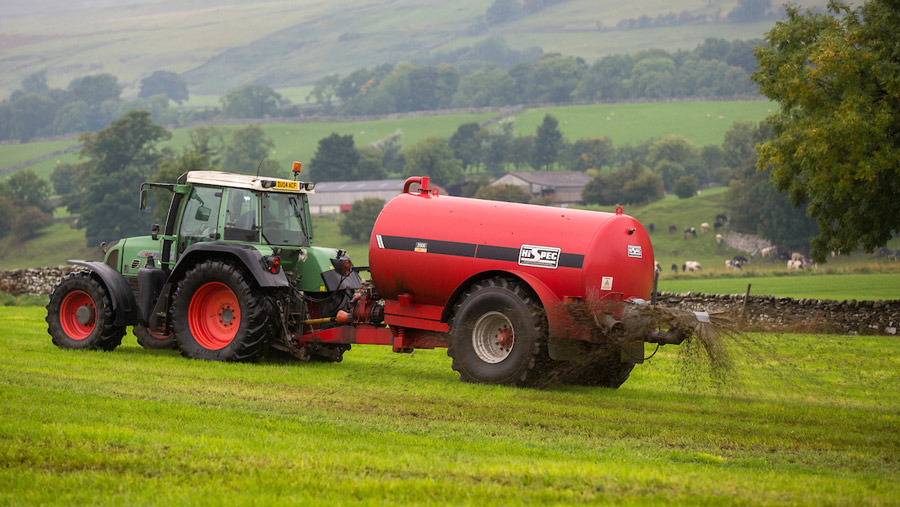Scots farmers face tougher slurry and silage restrictions
 © Tim Scrivener
© Tim Scrivener Farmers in Scotland face tougher restrictions on slurry and silage handling after the Scottish government launched proposals to curb water pollution risks.
The proposals, which are within a consultation document published on 20 January, include outright bans on certain slurry-spreading methods.
There are also plans to enforce major improvement work on silage clamps and slurry storage.
Farmers have until 13 April 2021 to respond to the consultation via the Scottish government’s website.
See also: Expert advice on setting up the perfect umbilical slurry system
Slurry spreading
The Scottish government said most of the 6.35m tonnes of slurry and digestate produced annually in Scotland were spread directly on to farmland.
Conventionally, this is carried out using rain guns or high-trajectory upward splash-plates on tankers.
But these methods contribute to higher ammonia emissions and Holyrood has proposed a complete ban on rain guns and splash plate, “swan-neck” or “bent-elbow” attachments.
Instead, farmers will be forced to use dribble bars, band spreaders, trailing hoses, trailed shoes or slurry injection.
The government acknowledged that this carried a potentially huge cost. To reduce the effect, it suggested a phased approach to enforcement after the proposed legislation was introduced.
Farms with more than 200 milking cows, 200 beef cattle or 800 fattening pigs or breeding sows would be given one year to comply. Farms with fewer animals would be allowed a five-year grace period.
However, this applies to slurry only. Because liquid digestate from biodigesters can be more susceptible to ammonia loss, all farms would have just one year’s grace.
Along with the slurry spreading rules, the government said all farmers would have to complete a risk assessment for manure and slurry in the future.
This would include mapping the farm to show:
- The delineation of every field
- The location of all surface water, wells and boreholes
- Any land with a slope of 12deg or more
- The location of any field heaps
- Any other area of high risk to the water environment.
More information
Scottish government consultation document
Deadline: 13 April 2021
Respond via the Scottish government’s website
Contact: eqce@gov.scot
Slurry storage
Crucially, all stores would be brought into line with the proposed improvements.
Currently, farms with stores and lagoons constructed before 1 September 1991 are exempt from storing silage, slurry and agricultural fuel oil regulations. But this exemption would be removed and farmers allowed four years to upgrade or construct new storage. Any stores built after 1 September 1991 that failed to comply would be allowed two years to carry out necessary upgrades.
Proposed slurry storage rules:
- Lagoons must have an impermeable liner fitted
- Slurry bags must be held within lined, bunded containment areas
- Storage must have sufficient capacity to contain slurry for:
– 26 weeks in housed pig units
– 22 weeks with housed cattle - Storage systems must have a life expectancy of more than 20 years
- Base, walls, channels, reception pit, and pipes must be impermeable
- Corrosion protection must meet British standards
- Stores should be more than 10m from surface water or drains
- An engineering plan and certificate must be provided
Silage storage
Like slurry stores, older silage clamps constructed before 1 September 1991 will no longer be exempt from the revised rules.
These farms will be given four years to carry out work while farmers with clamps built later will have a two-year transitional period to comply.
Further new rules apply ahead of the construction phase.
It has been practice for farmers to give notification 28 days before a new or upgraded clamp comes into operation. But, if the proposals go ahead, farmers will have to notify the Scottish Environment Protection Agency before construction starts.
Proposed silage storage rules
- Bases must:
– be impermeable
– extend beyond retaining walls
– meet British standards - Capacity of the effluent tank must be at least:
– 20 litres for every 1cu m of capacity for 1,500cu m clamps
– At least 30,000 litres plus 6.7 litres for every 1cu m of silo capacity over 1,500cu m - Bases, walls, effluent tanks and channels must be resistant to corrosion
- Earth walls must be lined with an impermeable membrane
- Clamps and baled silage must be at least 10m away from watercourses and drains.
